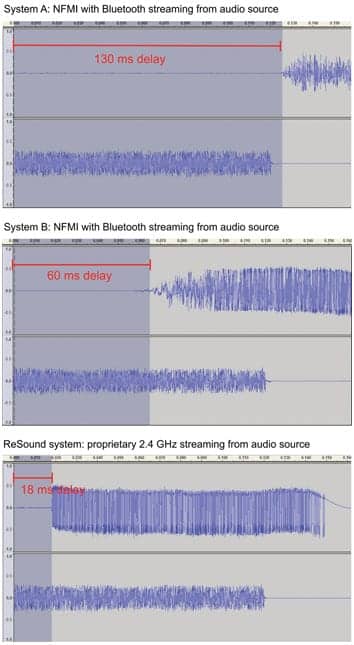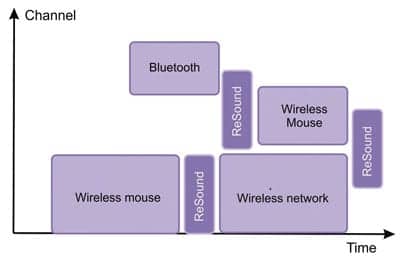As digital wireless features have evolved in hearing aids, confusion about these applications has increased. This article addresses some of the misconceptions about digital wireless systems.
Hearing instruments with digital wireless features have been around for a number of years. Initially, the wireless technology was used for the convenience of managing user controls on bilaterally fit devices simultaneously, but functionality has been added to facilitate hearing instrument use in multiple listening situations, such as when watching television or talking on the phone.
As new digital wireless hearing instrument systems continue to be introduced, confusion understandably arises as to how these systems compare. The first systems were based on near-field magnetic induction (NFMI), while the most recent generation of digital wireless systems use radio frequency (RF). Both of these technologies offer benefits and trade-offs: NFMI is quickly and relatively easily implemented in hearing instruments, as the technology is similar to the well-established telecoil; RF is challenging for manufacturers to achieve, but allows far-field transmission directly from sound sources to the hearing instruments.
This article will address some of the misconceptions that have surfaced as more manufacturers introduce digital wireless hearing instrument systems.
Myth #1: “Wireless hearing aids are Bluetooth.”
The term wireless refers to the transmission of information for many diverse purposes without the use of wires or cables. There are numerous technologies that qualify as wireless. Furthermore, wireless transmission can be either analog or digital. Hearing aids have utilized analog wireless technology in the form of telecoils or FM systems for up to 60 years. Use of these technologies can benefit the user by greatly improving the signal-to-noise ratio (SNR) in certain situations.
More recently, hearing instruments have become available that use digital wireless transmission, either to exchange information between right and left devices or to receive information from another source like a television or telephone. As with digital hearing instruments, digital wireless transmission enables more possibilities for signal processing than analog. In addition, digital wireless transmission generally has improved SNR compared to analog and, depending on the particular technology, less susceptibility to interference and encoding for privacy. Digital wireless hearing aid features can thus extend and expand on the already established benefits of analog wireless.
As mentioned above, the digital wireless technologies currently used in hearing instruments are NFMI and RF. Bluetooth specifically is an RF technology, but is not implemented within hearing instruments—although many devices that would be convenient for hearing instruments to communicate with are Bluetooth enabled.
Bluetooth is an open standard for wireless communication. It can be used for myriad applications, not only encompassing streaming of audio signals, but also such diverse things as wireless computer networks, game controllers, and even programmers for electricity meters. Currently, there are nearly 12,000 different products using Bluetooth. Communication protocols for Bluetooth must therefore be broad enough and flexible enough to accommodate these many uses. Because of this, Bluetooth requires much more power to operate than would be practical or acceptable in hearing aids.
So how does Bluetooth apply to wireless hearing aids? For hearing instruments with wireless features based on NFMI, Bluetooth is used for transmission of audio from a sound source to a body-worn relay device. This relay device converts the Bluetooth radio signal to a non-propagating modulating magnetic field. A neck loop attached to the relay device serves as the antenna of the transmitter, and the signal is picked up by a telecoil-like antenna in the hearing instruments. If the sound source is Bluetooth enabled—as is often the case with cell phones—it can transmit directly to the relay device. If the sound source is not Bluetooth enabled, a Bluetooth adaptor for the sound source is required in addition to the relay device.
For wireless hearing instruments based on RF technology, an adaptor is required to connect to sound sources, regardless of whether they are Bluetooth enabled, but this adaptor transmits the sound directly to receivers in the hearing instruments themselves.
Fact #1: Digital wireless hearing aids can communicate with Bluetooth-enabled devices via an adaptor that converts the Bluetooth signal to the technology used by the hearing instrument.
Myth #2: “Wireless hearing aids require the user to wear a medallion around their neck.”
Currently, the digital wireless technology in hearing aids serve three purposes:
- Communication between right and left hearing instruments for convenient control of program and volume changes, and/or to coordinate signal processing between right and left hearing instruments;
- Communication with a remote control to operate the hearing instruments;
- Streaming of audio from other devices, such as telephones, televisions, stereos, computers, or personal music players.
The first type of function involving communication between right and left hearing instruments does not require any extra device to be worn by the user. Operation of the hearing instruments with a remote control also does not necessarily require a device to be worn by the user. However, wireless hearing instruments based on NFMI may combine remote control functions with audio streaming functions, which do require a body-worn relay device. Audio streaming from other devices is the function that most differentiates the digital wireless technologies in hearing instruments today.
NFMI systems do not radiate or propagate the signal. They contain the transmission energy within a localized magnetic field around the transmitting antenna (neck loop). This type of transmission is referred to as near-field. There is a significant roll-off in the power density of near-field transmissions with distance, limiting the useful range of a NFMI system to 3 to 5 feet. This means that, in order for hearing instruments to receive signals from greater distances, a relay device based on a technology with longer range is required. Current NFMI systems rely on Bluetooth wireless communication from sound sources to a relay device that converts the signal to a modulated magnetic field. These systems use an induction coil located in a neck loop as the transmitting antenna, which is why a “medallion” is required.
RF systems use an antenna to generate and transmit a propagated electromagnetic wave. An electromagnetic wave is made up of an electrical field and a magnetic field. Because the signal is radiated in such a system, the attenuation of the signal over distance is much less than with NFMI. The effective transmission range can be 23 to 30 feet. This type of transmission is referred to as far-field.
With far-field transmission, an adaptor can connect to sound sources and send to receiving antennas embedded in the hearing instruments. No relay device is needed, and thus users need not wear a “medallion.”
Fact #2: Depending on the particular wireless function and the digital wireless technology used by the hearing instruments, users may need to wear a medallion, which is a relay device with an inductive neck loop. Systems based on radio frequency transmission do not require a medallion for any wireless functions, as far-field transmission to the hearing instruments is possible.
Myth #3: “All wireless hearing aids work the same way.”
Hearing instruments with wireless functionality have similar goals in terms of user benefit. A main user benefit—and one that is highly important to hearing instrument users—is connecting directly to sound sources like televisions and cell phones for better hearing in these situations.1 Wireless streaming of audio from such far-field sources to hearing instruments is a common purpose for the available systems. Other goals are to facilitate operation of the hearing instruments and to coordinate signal processing between bilaterally worn hearing instruments.
Although all wireless hearing instruments share at least the goals of audio streaming and facilitating hearing instrument operation, these goals are achieved in different ways. As mentioned, NFMI-based systems use Bluetooth—a far-field wireless technology—to stream from audio sources to a body-worn relay device, and this device communicates with the hearing instruments via magnetic induction. Additionally, the body-worn relay device may serve as a remote control for the hearing instruments. Because RF is far-field by nature, wireless hearing aid systems based on this technology communicate directly with an adaptor connected to audio sources. In general, RF systems use dedicated devices to serve different functions. Thus, a remote control for operating the hearing instruments is separate from the adaptors that connect to audio sources.
For the user, there are advantages to both NFMI and RF systems, and there will be individual preferences. NFMI systems combine many functions in the relay device, such as remote control, receiver for streamed audio from the television, and cell phone receiver and microphone. Some users may appreciate this type of “all-in-one” functionality. In contrast, RF systems treat the hearing instruments as the center of the system, and dedicated accessories—such as an audio streamer connected to the television, cell phone “headset,” and remote control—are separate. Some users may prefer the discretion and mobility afforded by the small and simple accessories that transmit over longer ranges directly to the hearing instruments.
Fact #3: Although hearing instruments with digital wireless features have similar goals in terms of user benefits, the working principles by which these goals are achieved are different. There are concrete differences for the user in what accessory devices are required and how they operate.
Myth #4: “Any hearing aid that connects the user to the phone or television will do the same job.”
Hearing instruments using digital wireless technology to connect to audio sources aim to improve signal-to-noise ratio and provide good sound quality for the user. However, just as there are differences in hearing instrument sound processing, differences in the way wireless functionality is achieved can impact user benefit.
One aspect of user benefit that can be affected is sound quality. Bluetooth is used to stream audio to the body-worn streamers of NFMI-based wireless hearing aid systems. This introduces a delay that may be unacceptable for television viewing, particularly in the case where direct sound and streamed sound are combined.
Bluetooth-based systems that stream audio use a method called A2DP (Advanced Audio Distribution Profile) that describes how Bluetooth enabled devices, such as an MP3 player or a microphone, can transmit audio to a receiving device such as a wireless headset. The latency for this protocol exceeds 40 milliseconds and is commonly up to 125 milliseconds, depending on the audio compression technique that is used. If the streamed sound combines with sound amplified via the hearing instrument microphones, or with direct sound entering the ear canals in an open fitting, delays of this magnitude are likely to cause the perception of echoes and even lip-synch issues when watching television.

FIGURE 1. The delay of streamed sound relative to direct acoustic sound for two NFMI-based wireless hearing instrument systems and the ReSound 2.4 GHz wireless system. The NFMI systems stream from the audio source to the body-worn streamer using Bluetooth, which causes large delays. System B likely uses “low density” audio compression, resulting in poor audio quality. The ReSound system uses high density audio compression and keeps delay low for optimum audio quality.
Figure 1 compares delays of audio signals streamed from a home stereo system to three wireless hearing instrument systems. The delay is measured by comparing the arrival of the sound coming from a loudspeaker to the ear of a KEMAR manikin with the arrival of the sound arriving in the ear via the wireless transmission and hearing instrument. The NFMI-based systems that stream from the audio source via Bluetooth introduce very large delays that are likely to be disturbing for listeners.
Another difference between NFMI and RF systems related to streaming is that NFMI systems have a 1-to-1 relationship between audio sources and the body-worn streamer. This means that two people wearing hearing instruments with the same wireless capabilities would not be able to share streaming devices in their home: two separate streaming devices connected to the television would be required, as would two streaming devices connected to the telephone. Likewise, the hearing instrument user with a television in both the living room and the bedroom would not be able to connect to separate streaming devices, but would have to move the same streaming device from room to room.
Although RF-based systems do not have this restriction, there are differences among these systems regarding streaming devices, as well. One RF system allows the hearing instruments to receive signals from any of its dedicated accessories without specifically assigning them to communicate. On the one hand, this is simple for users as no “pairing” procedure is required in order to use these accessories with the hearing instruments. On the other hand, it is not possible for accessories to be too near each other, as the signals will interrupt each other, essentially competing for the hearing instrument user’s attention. RF systems that specifically pair hearing aids with wireless accessories prevent interference between accessories that are in proximity to each other.
RF systems may use different transmission frequencies. Current systems use either the 900 MHz or the 2.4 GHz license-free ISM (Industry Science Medical) bands. The 2.4 GHz ISM band is particularly convenient, as it can be used internationally, while the use of the 900 MHz ISM band is limited to Region 2 (the Americas, Greenland, and certain eastern Pacific Islands).
Apart from these regulatory considerations, the choice of frequency for RF systems also impacts the size of the antennas needed for transmission, and thus the size of the devices. There is a fixed relationship between the frequency and the physical dimensions of the antenna, with a lower frequency requiring a longer antenna. Antennas in the hearing instruments must be very small. For a 900 MHz system, this means that the antennas in the transmitting devices must be much larger to compensate. Thus, the wireless accessories of this lower frequency system need to be made larger than is necessary for the higher frequency 2.4 GHz-based system. Individual preferences of the user determine whether this is of importance in choosing a system.
Fact #4: The different wireless technologies used for hearing instruments result in important differences in: 1) the sound quality of streamed sound; 2) the convenience, flexibility, and size of the wireless accessories, and 3) the ability to use the system when traveling internationally.
Myth #5: “Wireless hearing aids that transmit at 2.4 GHz will have problems with interference.”
This statement is most often heard as an argument in favor of NFMI-based systems. Indeed, the chances of interference of transmission to the hearing instruments within the magnetic field created by the relay device and neck loop are very small. The irony, however, is that these systems use Bluetooth—which operates in the 2.4 GHz ISM band—for wireless transmission from sound sources to the relay device.

FIGURE 2. ReSound transmits data in exceedingly small time intervals to avoid conflict with other transmitting devices operating in the 2.4 GHz band.
Therefore, NFMI systems, in practical terms, are no more or less susceptible to interference than RF systems. The robustness of the transmission for both types of systems ultimately depends on techniques used for RF. As witness to the effectiveness of such techniques, RF is the only type of digital wireless technology used in communications equipment for military, police, rescue, and firefighters because of its long range, data security, and robustness to interference.
Both the 2.4 GHz and 900 MHz bands host a large number of wireless devices that could potentially cause interference, so safeguards for robust transmission are extremely important. For example, the ReSound 2.4 GHz wireless technology uses techniques similar to other equipment operating in these ranges, and can be considered as an example of how interference is avoided.
ReSound uses two methods to protect against interference of wireless transmission of data. The first is time division (Figure 2). The rules governing operation in the 2.4 GHz band specify that no device must transmit for more than 0.4 seconds at a time on a given channel. This means that, even in heavily congested channels, small time slots appear where the channel is free. To exploit this, ReSound sends very short data packets—only between 160 and 500 microseconds (or 0.00016 to 0.0005 second) long. Such a short packet has a high chance of getting through simply because of its length.
The second method is spread spectrum frequency hopping (Figure 3). The ReSound system divides the 2.4 GHz band into 35 channels. With frequency hopping, each time a new piece of data is to be sent, a new channel out of the 35 possible channels is chosen for the transmission. The hearing instrument mutually agrees with the wireless accessory on which channel to send the next data packet. Because all the different devices in the 2.4 GHz band use a different selection strategy, they virtually always steer clear of each other. This technique works better for the higher transmission frequencies, such as 2.4 GHz, because the pulses of data transmission are narrower. In other words, the amount of time the data packet is “in the air” is shorter at higher frequencies. As mentioned, a shorter transmission time greatly reduces the chances of interference.

FIGURE 3. In addition to transmitting in very short time intervals (as indicated by the horizontal axis), ReSound technology makes use of 35 different channels (vertical axis) in the 2.4 GHz band to avoid disturbance from other wireless devices. This graph gives an impression of how other types of wireless device transmissions are distributed relative to ReSound technology.
Fact #5: All digital wireless hearing instrument systems on the market today rely to some extent on RF transmission. Well-established and successful techniques for robust transmission are used by these systems.
Summary
While the first digital wireless hearing instrument systems were based on near-field magnetic induction, the second generation use radio frequency. Both types of technologies offer benefits to the user. The newer radio frequency systems aim to increase convenience and mobility, as well as sound quality, with direct transmission between sound sources and embedded antennas in the hearing instruments.
Uncertainties regarding relative advantages and disadvantages of these two technologies have emerged, and this article discussed some of the most common concerns and questions.
ReSound chose a proprietary 2.4 GHz-based system for its wireless hearing instruments based on market research showing that users prioritized a simple, hearing instrument-driven solution that could be used for robust connections to external sources with the best audio quality. This market research also suggests that not only is the 2.4 GHz RF technology currently the optimum solution to satisfy these requirements, but it also allows many future developments, such as synchronization and exchange of data between hearing instruments, as well as additional accessories for added convenience in interacting with external devices.
Reference
- Groth J, Anthonsen A. Fewer wires, less complexity, and more connections: the new challenge for wireless hearing instruments. Hearing Review. 2010;17(6):28-36.
Citation for this article:
Groth J. Five myths about digital wireless hearing aid technology. Hearing Review. 2010;17(13):24-30.






